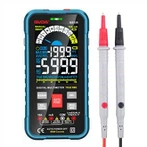Measurement of switching power supply ripple
Switching power supply ripple generation
Our purpose is to reduce the output ripple to a tolerable level, to achieve this purpose the most fundamental solution is to try to avoid the generation of ripple, first of all, we must be clear about the type of switching power supply ripple and the reasons for its generation.
Following the switching of the SWITCH, the current in the inductor L also fluctuates up and down in the RMS value of the output current. So the output will also be flooded with a ripple with the same frequency as the SWITCH, generally referred to as ripple is this. It has a relationship with the capacity of the output capacitor and ESR. The frequency of this ripple is the same as the switching power supply, tens to hundreds of KHz.
In addition, SWITCH generally choose bipolar transistors or MOSFETs, either one, in its on and off, there will be a rise time and fall time. At this time in the circuit will be flooded with a SWITCH rise and fall time of the same frequency or an odd multiple of the frequency of the noise, generally tens of MHz. the same diode D in the reverse recovery moment, the equivalent circuit for the resistance capacitance and inductance of the series connection, will cause resonance, resulting in the noise frequency of several tens of MHz. these two types of noise is generally called high-frequency noise, amplitude is usually much larger than the ripple.
If the AC/DC converter, in addition to the above two ripple (noise), there is AC noise, the frequency is the frequency of the input AC power supply, for about 50 to 60Hz. There is also a common-mode noise, caused by the equivalent capacitance generated by the power devices of many switching power supplies using the case as a heat sink. As I am doing automotive electronics research and development, for the latter two types of noise exposure is less, so do not consider for the time being.
Basic requirements: use oscilloscope AC coupling, 20MHz bandwidth limit, unplug the probe's earth wire
1, AC coupling is to remove the superimposed DC voltage to get the correct waveform.
2, Open the 20MHz bandwidth limit is to prevent the interference of high-frequency noise, preventing the measurement of the wrong results. Due to the high-frequency component amplitude is large, should be removed when measuring.
3, pull out the oscilloscope probe grounding clip, use the grounding ring measurement, in order to reduce interference. Many parts do not have a grounding ring, if the error promises to directly use the probe grounding clip measurement. However, this factor should be taken into account when determining whether it is qualified.
Another point is to use a 50Ω terminal. Yokogawa oscilloscope information on the first said that the 50Ω module is to remove the DC component, measuring the AC component. But few oscilloscopes with this special probe, most cases are measured using the standard 100KΩ to 10MΩ probe, the impact is not clear for the time being.
The above is the measurement of switching ripple when the basic attention. If the oscilloscope probe is not in direct contact with the output point, you should use a twisted pair, or 50Ω coaxial cable measurement.
When measuring high-frequency noise, use the full passband of the oscilloscope, typically a few hundred megabytes to the GHz level. Others are the same as above. It may be that different companies have different test methods. At the end of the day **be clear about your test results. **To be recognised by the customer.






